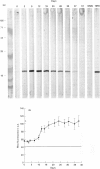Abstract
Immunosuppressive retrovirus-related proteins, like p15E, are involved in tumour-associated immunosuppression. In the present study we investigated whether such proteins could be used as targets in tumour immunotherapy using MoAbs. Immunotherapy was performed in mice inoculated with the Rauscher virus-transformed myeloid cell line RMB-1. RMB-1 cells express retroviral antigens at their cell surface. In order to obtain constant serum titres of MoAbs over a prolonged period of time during therapy, anti-p15E antibody-producing hybridoma cells were encapsulated in alginate and injected intraperitoneally in tumour-bearing mice. Using this technique, serum antibody titres of 50-100 micrograms/ml were obtained, which remained constant over a period of at least 3 weeks. Therapy experiments were performed using anti-p15E antibodies 19F8, which recognizes both cell surface-associated as well as circulating p15E, and ER-IS5, which did not react with surface-bound p15E beyond background, but which neutralizes circulating p15E. Inoculation of alginates containing anti-p15E hybridoma cell lines in RMB-1 tumour-bearing mice showed inhibition of tumour cell growth. In survival experiments, 19F8 cured eight of 23 tumour-bearing mice. The p15E neutralizing antibody ER-IS5 caused a significant longer survival, but therapy with this MoAb alone was not sufficient to cure the animals of the RMB-1 tumour.
Full text
PDF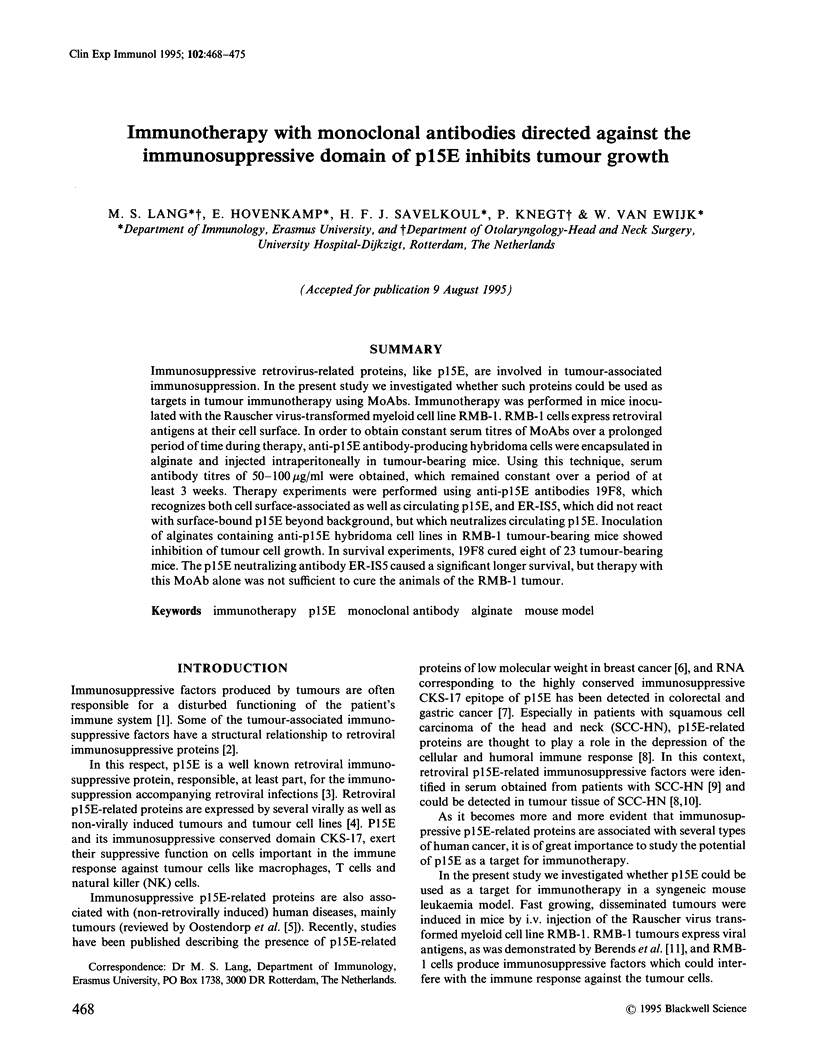
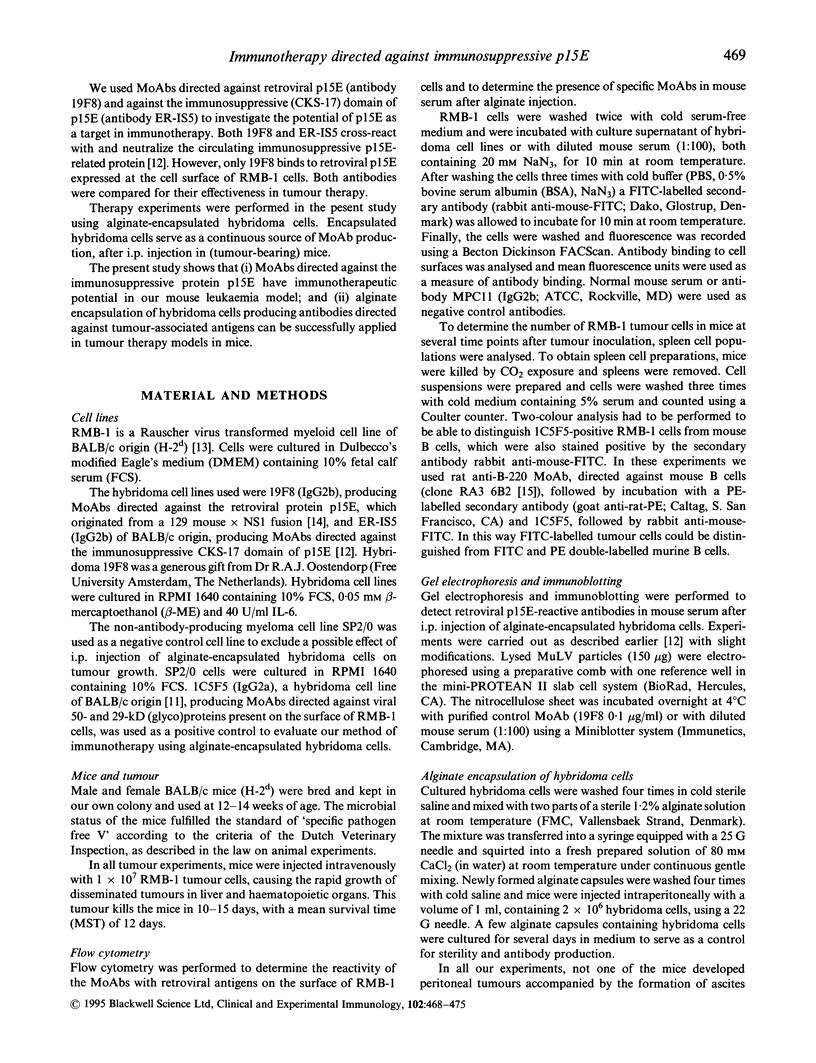
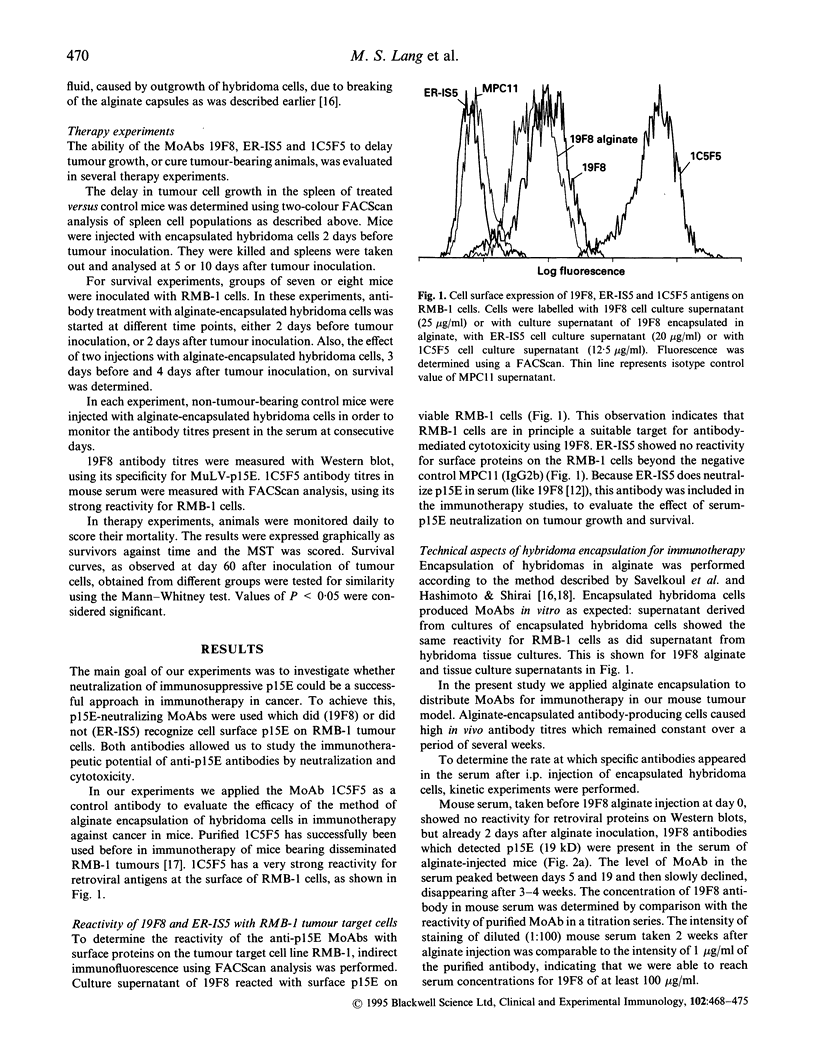
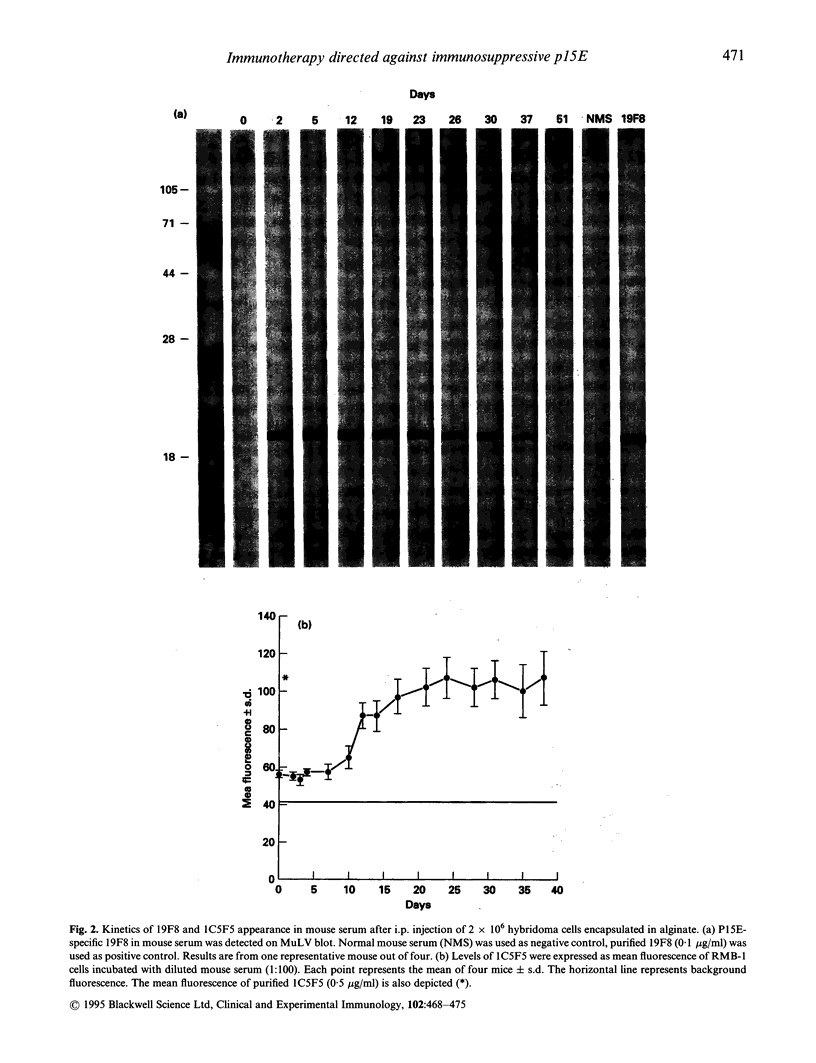
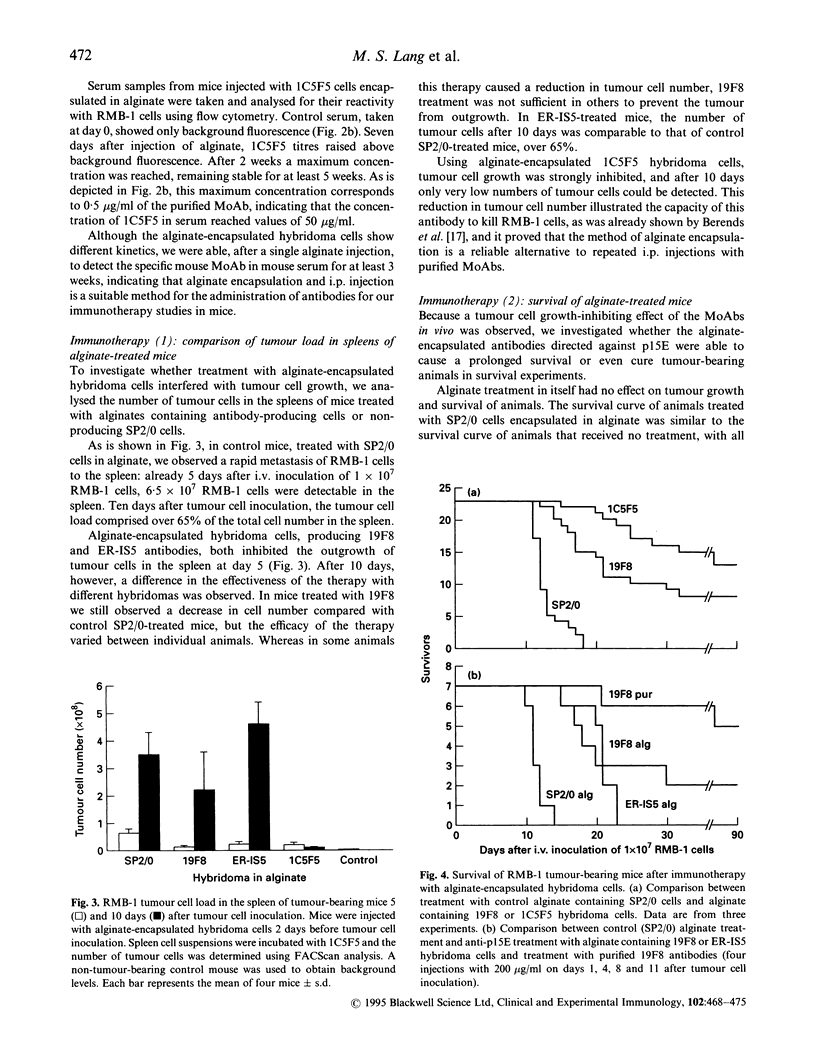
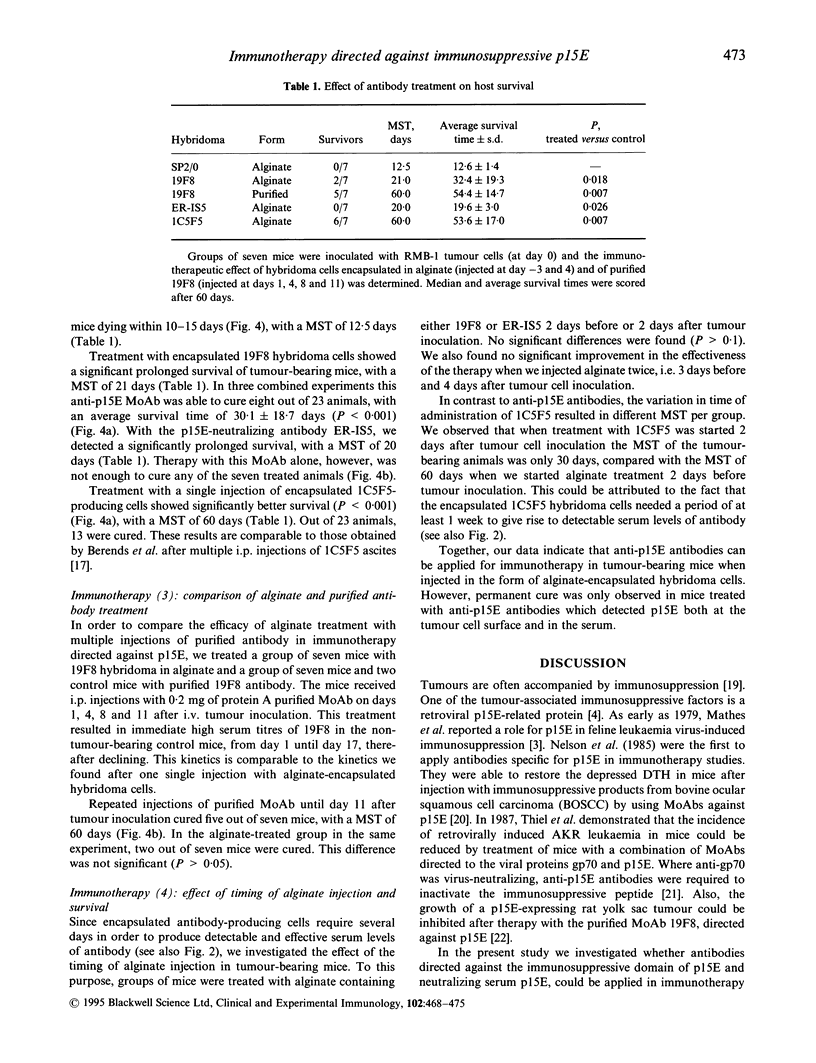
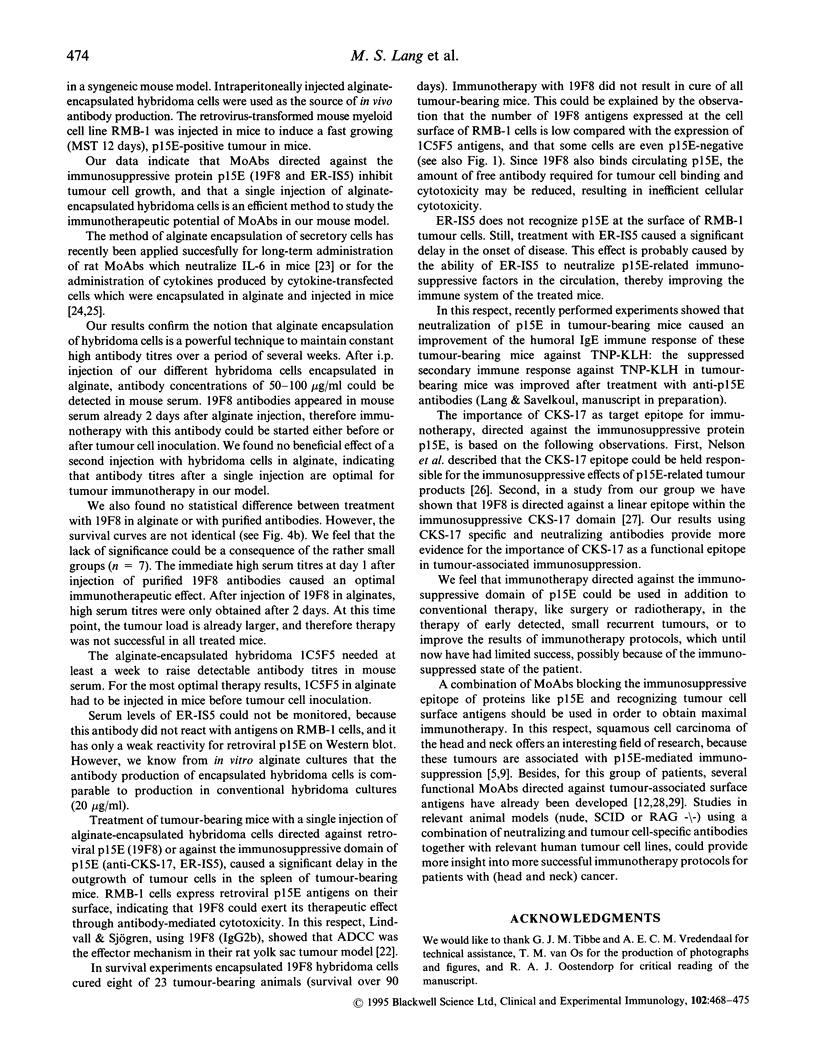
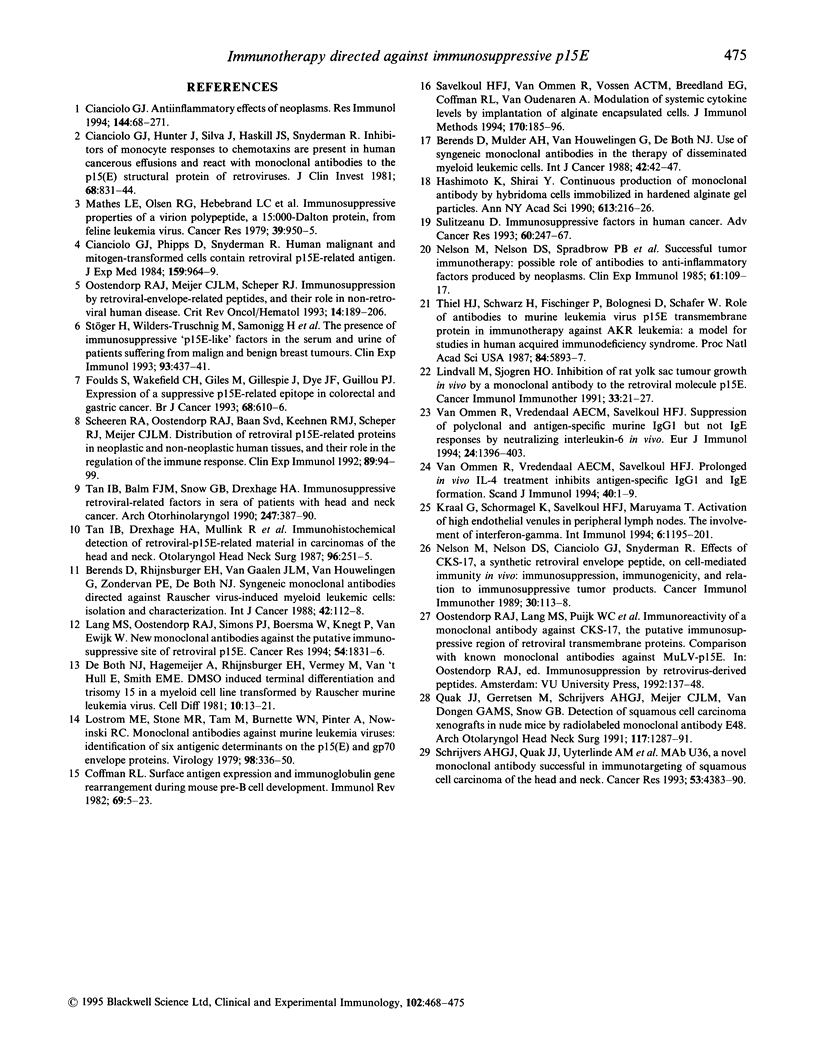
Images in this article
Selected References
These references are in PubMed. This may not be the complete list of references from this article.
- Berends D., Mulder A. H., van Houwelingen G., de Both N. J. Use of syngeneic monoclonal antibodies in the therapy of disseminated myeloid leukemic cells. Int J Cancer. 1988 Jul 15;42(1):42–47. doi: 10.1002/ijc.2910420109. [DOI] [PubMed] [Google Scholar]
- Berends D., Rhijnsburger E. H., van Gaalen J. L., van Houwelingen G., Zondervan P. E., de Both N. J. Syngeneic monoclonal antibodies directed against Rauscher virus-induced myeloid leukemic cells: isolation and characterization. Int J Cancer. 1988 Jul 15;42(1):112–118. doi: 10.1002/ijc.2910420121. [DOI] [PubMed] [Google Scholar]
- Cianciolo G. J., Phipps D., Snyderman R. Human malignant and mitogen-transformed cells contain retroviral P15E-related antigen. J Exp Med. 1984 Mar 1;159(3):964–969. doi: 10.1084/jem.159.3.964. [DOI] [PMC free article] [PubMed] [Google Scholar]
- Cianciolo G., Hunter J., Silva J., Haskill J. S., Snyderman R. Inhibitors of monocyte responses to chemotaxins are present in human cancerous effusions and react with monoclonal antibodies to the P15(E) structural protein of retroviruses. J Clin Invest. 1981 Oct;68(4):831–844. doi: 10.1172/JCI110338. [DOI] [PMC free article] [PubMed] [Google Scholar]
- Coffman R. L. Surface antigen expression and immunoglobulin gene rearrangement during mouse pre-B cell development. Immunol Rev. 1982;69:5–23. doi: 10.1111/j.1600-065x.1983.tb00446.x. [DOI] [PubMed] [Google Scholar]
- Foulds S., Wakefield C. H., Giles M., Gillespie J., Dye J. F., Guillou P. J. Expression of a suppressive p15E-related epitope in colorectal and gastric cancer. Br J Cancer. 1993 Sep;68(3):610–616. doi: 10.1038/bjc.1993.395. [DOI] [PMC free article] [PubMed] [Google Scholar]
- Hashimoto K., Shirai Y. Continuous production of monoclonal antibody by hybridoma cells immobilized in hardened alginate gel particles. Ann N Y Acad Sci. 1990;613:216–226. doi: 10.1111/j.1749-6632.1990.tb18163.x. [DOI] [PubMed] [Google Scholar]
- Kraal G., Schornagel K., Savelkoul H., Maruyama T. Activation of high endothelial venules in peripheral lymph nodes. The involvement of interferon-gamma. Int Immunol. 1994 Aug;6(8):1195–1201. doi: 10.1093/intimm/6.8.1195. [DOI] [PubMed] [Google Scholar]
- Lang M. S., Oostendorp R. A., Simons P. J., Boersma W., Knegt P., van Ewijk W. New monoclonal antibodies against the putative immunosuppressive site of retroviral p15E. Cancer Res. 1994 Apr 1;54(7):1831–1836. [PubMed] [Google Scholar]
- Lindvall M., Sjögren H. O. Inhibition of rat yolk sac tumour growth in vivo by a monoclonal antibody to the retroviral molecule P15E. Cancer Immunol Immunother. 1991;33(1):21–27. doi: 10.1007/BF01742523. [DOI] [PMC free article] [PubMed] [Google Scholar]
- Lostrom M. E., Stone M. R., Tam M., Burnette W. N., Pinter A., Nowinski R. C. Monoclonal antibodies against murine leukemia viruses: identification of six antigenic determinants on the p 15(E) and gp70 envelope proteins. Virology. 1979 Oct 30;98(2):336–350. doi: 10.1016/0042-6822(79)90557-9. [DOI] [PubMed] [Google Scholar]
- Mathes L. E., Olsen R. G., Hebebrand L. C., Hoover E. A., Schaller J. P., Adams P. W., Nichols W. S. Immunosuppressive properties of a virion polypeptide, a 15,000-dalton protein, from feline leukemia virus. Cancer Res. 1979 Mar;39(3):950–955. [PubMed] [Google Scholar]
- Nelson M., Nelson D. S., Cianciolo G. J., Snyderman R. Effects of CKS-17, a synthetic retroviral envelope peptide, on cell-mediated immunity in vivo: immunosuppression, immunogenicity, and relation to immunosuppressive tumor products. Cancer Immunol Immunother. 1989;30(2):113–118. doi: 10.1007/BF01665962. [DOI] [PMC free article] [PubMed] [Google Scholar]
- Nelson M., Nelson D. S., Spradbrow P. B., Kuchroo V. K., Jennings P. A., Cianciolo G. J., Snyderman R. Successful tumour immunotherapy: possible role of antibodies to anti-inflammatory factors produced by neoplasms. Clin Exp Immunol. 1985 Jul;61(1):109–117. [PMC free article] [PubMed] [Google Scholar]
- Oostendorp R. A., Meijer C. J., Scheper R. J. Immunosuppression by retroviral-envelope-related proteins, and their role in non-retroviral human disease. Crit Rev Oncol Hematol. 1993 Jun;14(3):189–206. doi: 10.1016/1040-8428(93)90009-s. [DOI] [PubMed] [Google Scholar]
- Quak J. J., Gerretsen M., Schrijvers A. H., Meijer C. J., van Dongen G. A., Snow G. B. Detection of squamous cell carcinoma xenografts in nude mice by radiolabeled monoclonal antibody E48. Arch Otolaryngol Head Neck Surg. 1991 Nov;117(11):1287–1291. doi: 10.1001/archotol.1991.01870230103017. [DOI] [PubMed] [Google Scholar]
- Savelkoul H. F., van Ommen R., Vossen A. C., Breedland E. G., Coffman R. L., van Oudenaren A. Modulation of systemic cytokine levels by implantation of alginate encapsulated cells. J Immunol Methods. 1994 Apr 15;170(2):185–196. doi: 10.1016/0022-1759(94)90394-8. [DOI] [PubMed] [Google Scholar]
- Scheeren R. A., Oostendorp R. A., van der Baan S., Keehnen R. M., Scheper R. J., Meijer C. J. Distribution of retroviral p15E-related proteins in neoplastic and non-neoplastic human tissues, and their role in the regulation of the immune response. Clin Exp Immunol. 1992 Jul;89(1):94–99. doi: 10.1111/j.1365-2249.1992.tb06884.x. [DOI] [PMC free article] [PubMed] [Google Scholar]
- Schrijvers A. H., Quak J. J., Uyterlinde A. M., van Walsum M., Meijer C. J., Snow G. B., van Dongen G. A. MAb U36, a novel monoclonal antibody successful in immunotargeting of squamous cell carcinoma of the head and neck. Cancer Res. 1993 Sep 15;53(18):4383–4390. [PubMed] [Google Scholar]
- Stöger H., Wilders-Truschnig M., Samonigg H., Schmid M., Bauernhofer T., Tiran A., Tas M., Drexhage H. A. The presence of immunosuppressive 'p15E-like' factors in the serum and urine of patients suffering from malign and benign breast tumours. Clin Exp Immunol. 1993 Sep;93(3):437–441. doi: 10.1111/j.1365-2249.1993.tb08197.x. [DOI] [PMC free article] [PubMed] [Google Scholar]
- Sulitzeanu D. Immunosuppressive factors in human cancer. Adv Cancer Res. 1993;60:247–267. doi: 10.1016/s0065-230x(08)60827-1. [DOI] [PubMed] [Google Scholar]
- Tan I. B., Balm A. J., Snow G. B., Drexhage H. A. Immunosuppressive retroviral-related factors in sera of patients with head and neck cancer. Eur Arch Otorhinolaryngol. 1990;247(6):387–390. doi: 10.1007/BF00179016. [DOI] [PubMed] [Google Scholar]
- Tan I. B., Drexhage H. A., Mullink R., Hensen-Logmans S., De Haan-Meulman M., Snow G. B., Balm A. J. Immunohistochemical detection of retroviral-P15E-related material in carcinomas of the head and neck. Otolaryngol Head Neck Surg. 1987 Mar;96(3):251–255. doi: 10.1177/019459988709600304. [DOI] [PubMed] [Google Scholar]
- Thiel H. J., Schwarz H., Fischinger P., Bolognesi D., Schäfer W. Role of antibodies to murine leukemia virus p15E transmembrane protein in immunotherapy against AKR leukemia: a model for studies in human acquired immunodeficiency syndrome. Proc Natl Acad Sci U S A. 1987 Aug;84(16):5893–5897. doi: 10.1073/pnas.84.16.5893. [DOI] [PMC free article] [PubMed] [Google Scholar]
- de Both N. J., Hagemeijer A., Rhijnsburger E. H., Vermey M., van't Hull E., Smit E. M. DMSO-induced terminal differentiation and trisomy 15 in myeloid cell line transformed by the Rauscher murine leukemia virus. Cell Differ. 1981 Jan;10(1):13–21. doi: 10.1016/0045-6039(81)90043-9. [DOI] [PubMed] [Google Scholar]
- van Ommen R., Vredendaal A. E., Savelkoul H. F. Prolonged in vivo IL-4 treatment inhibits antigen-specific IgG1 and IgE formation. Scand J Immunol. 1994 Jul;40(1):1–9. doi: 10.1111/j.1365-3083.1994.tb03425.x. [DOI] [PubMed] [Google Scholar]
- van Ommen R., Vredendaal A. E., Savelkoul H. F. Suppression of polyclonal and antigen-specific murine IgG1 but not IgE responses by neutralizing interleukin-6 in vivo. Eur J Immunol. 1994 Jun;24(6):1396–1403. doi: 10.1002/eji.1830240624. [DOI] [PubMed] [Google Scholar]



